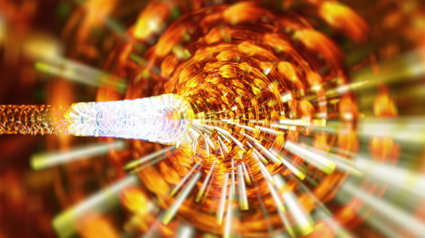The science and art of tangible things
Urszula Dawkins, Synapse: A Selection, Powerhouse

Chris Henschke, Lightcurve (infrared arc), 2011
courtesy the artist
Chris Henschke, Lightcurve (infrared arc), 2011
And down a few escalators to the lower decks of the Powerhouse, for a survey of recent work from ANAT’s Synapse arts/science residency program. With a distinctly different feel from SymbioticA’s semipermeable (+), Synapse: A Selection seems more grounded in ‘things’, in direct human engagement with life, with objects at macro scale. It seems that in the ‘wet biology’ terrain which defines much of SymbioticA’s output, the materials and life-forms that are investigated, manipulated and theorised are those that need to be apprehended in the context of the interventions, the art itself. But whether it’s by accident or alignment with a different approach, the things themselves lie at the heart of Synapse: A Selection – and indeed the heart, with all its bloody gore, is the subject of the work that most affected me in this show.
The first two works encountered are each balanced on a relationship: in the case of Nola Farman’s Animating Solar Technology (in progress), that of specific materials to temperature. On display are a series of maquettes of sculptural works that ‘remember’ their shape despite heating or cooling, designed to morph at daybreak and sunset. In a nearby video, artist Kirsty Boyle plays with a traditional Japanese mechanical doll. While Farman’s maquettes position technology in relationship to the natural environment, Boyle’s video is familiar, then uncanny. We watch her manipulate the doll’s limbs, gently testing its physical limits. But before long the doll exerts a converse influence: when she cradles it like a baby, strokes it, rests its head on her shoulder, it appears that the inanimate object directs her attention as surely as she moves its wooden parts.
Swirling imaginary renderings of the inside of a particle accelerator (Chris Henschke) and a still life tableau composed entirely of natural salt (Ken and Julia Yonetani) lie along the way to Erica Seccombe’s Grow, a 3D animation work employing xray tomography in its creation, to give a microscopic view of germinating seeds. In soft blues and golds the images float, evolving almost imperceptibly, the expanding heads of the seeds within their casings not unlike human foetuses twitching in the womb.
At the interactive heart of Synapse: A Selection, in the centre of the gallery space, is George Poonkin Khut’s BrightHearts – Embers iPad app. Created to help children learn and practise relaxation and anxiety management before and during painful procedures, the app monitors heart-rate via a sensor clipped to the earlobe. A sparse starfield is the background to changing concentric rings of colour which advance and recede; the sounds are pure, bright, soft, glockenspiely. It starts out red-themed; as my breathing slows the circles seem to soften, retreating to the middle distance. It’s hypnotic; it seems the display is responding to my vital signs, but also influencing them. It’s an aesthetically seductive, immersive, purposeful play of biofeedback, perfectly positioned on the cusp of art and technology.
Hidden in a small side room is the other ‘heart’ of this show – the visceral one: Peta Clancy and Helen Pynor’s Study Towards Aftermath. A video documentation of the perfusion of pig hearts, performed at the Science Gallery in Dublin earlier in 2013, the work cleanly records a technical process, but this documentation is both disturbing and acutely poetic.
From what I see, ‘perfusion’ entails taking the pig hearts, hooking them up to tubes, zapping them into apparent life with a defibrillator (don’t quote me on this), and pumping blood through them (or letting them do the pumping themselves); in this case into a large perspex ‘blood-catching’ apparatus. Against Gail Priest’s minimal soundtrack of gentle harmonic hums, soft and distant, we watch the set-up: the splattering blood as clamps are manipulated; the urinal-like containers into which the hearts bleed copiously; the audience clustered around. The cinematography is stunning: sharp-focused and built on primary colours, mostly red. The two hearts in their dead-but-animated state pump and bleed; at one point, one seems to hiccup blood – it’s gruesome. The cut arteries gape like too-soft mouths; the beating action is undulating, horribly sensuous, and riveting.
Synapse: A Selection meanders through diverse artistic and scientific territories, evoking fascination, horror or contemplation across disciplines, and infused (or perfused) with the sense of risk and experiment. As the quote from Einstein on the introductory panel asserts: “If we knew what it was we were doing, it would not be called research, would it?”






